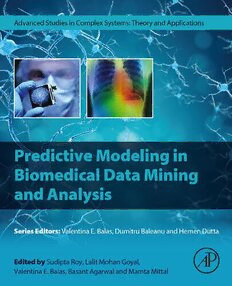Table Of ContentPredictive Modeling
in Biomedical Data Mining
and Analysis
This page intentionally left blank
Predictive Modeling
in Biomedical Data Mining
and Analysis
Edited by
Sudipta Roy
Department of Artificial Intelligence and Data Science, Jio Institute,
Navi Mumbai, Maharashtra, India
Lalit Mohan Goyal
Department of Computer Engineering, J C Bose University of Science
and Technology, YMCA, Faridabad, India
Valentina E. Balas
Professor of Automation and Applied Informatics, Aurel Vlaicu University
of Arad, Arad, Romania
Basant Agarwal
Department of Computer Science and Engineering, Indian Institute
of Information Technology Kota, Jaipur, Rajasthan, India
Mamta Mittal
Delhi Skill and Entrepreneurship University, New Delhi, India
AcademicPressisanimprintofElsevier
125LondonWall,LondonEC2Y5AS,UnitedKingdom
525BStreet,Suite1650,SanDiego,CA92101,UnitedStates
50HampshireStreet,5thFloor,Cambridge,MA02139,UnitedStates
TheBoulevard,LangfordLane,Kidlington,OxfordOX51GB,UnitedKingdom
Copyright©2022ElsevierInc.Allrightsreserved.
Nopartofthispublicationmaybereproducedortransmittedinanyformorbyanymeans,electronicor
mechanical,includingphotocopying,recording,oranyinformationstorageandretrievalsystem,without
permissioninwritingfromthepublisher.Detailsonhowtoseekpermission,furtherinformationaboutthe
Publisher’spermissionspoliciesandourarrangementswithorganizationssuchastheCopyrightClearance
CenterandtheCopyrightLicensingAgency,canbefoundatourwebsite:www.elsevier.com/permissions.
ThisbookandtheindividualcontributionscontainedinitareprotectedundercopyrightbythePublisher
(otherthanasmaybenotedherein).
Notices
Knowledgeandbestpracticeinthisfieldareconstantlychanging.Asnewresearchandexperiencebroadenour
understanding,changesinresearchmethods,professionalpractices,ormedicaltreatmentmaybecome
necessary.
Practitionersandresearchersmustalwaysrelyontheirownexperienceandknowledgeinevaluatingandusing
anyinformation,methods,compounds,orexperimentsdescribedherein.Inusingsuchinformationormethods
theyshouldbemindfuloftheirownsafetyandthesafetyofothers,includingpartiesforwhomtheyhavea
professionalresponsibility.
Tothefullestextentofthelaw,neitherthePublishernortheauthors,contributors,oreditors,assumeanyliability
foranyinjuryand/ordamagetopersonsorpropertyasamatterofproductsliability,negligenceorotherwise,or
fromanyuseoroperationofanymethods,products,instructions,orideascontainedinthematerialherein.
ISBN:978-0-323-99864-2
ForinformationonallAcademicPresspublications
visitourwebsiteathttps://www.elsevier.com/books-and-journals
Publisher:MaraE.Conner
AcquisitionsEditor:ChrisKatsaropoulos
EditorialProjectManager:FernandaA.Oliveira
ProductionProjectManager:AnithaSivaraj
CoverDesigner:GregHarris
TypesetbySTRAIVE,India
Contents
Contributors xi
About the Editors xv
Preface xix
1. Data mining with deep learning in biomedical data 1
KuldeepSinghandJyoteeshMalhotra
1. Introduction 1
2. Role of deep learning techniques in epileptic seizure
detection 3
3. Proposed method of seizure detection 5
4. Results and discussion 12
5. Conclusions 16
References 16
2. Applications of supervised machine learning techniques
with the goal of medical analysis and prediction:
A case study of breast cancer 21
KoushalKumarandBhagwatiPrasadPande
1. Introduction 21
2. A brief literature survey 23
3. Dataset and modus operandi 24
4. Data visualization 30
5. Feature selection and dimensionality reduction 33
6. Experimental results and discussions 39
7. Conclusions 45
References 46
v
vi Contents
3. Medical decision support system using data mining 49
N.L.Taranath,H.R.Roopashree,A.C.Yogeesh,L.M.Darshan,and
C.K.Subbaraya
1. Introduction 49
2. Medical decision support system: A review 50
3. Ontological representation of MDSS 53
4. Integrated medical decision support system 57
5. Conclusion and future enhancement 62
References 63
4. Role of AI techniques in enhancing multi-modality
medical image fusion results 65
HarmeetKaurandSatishKumar
1. Introduction 65
2. Modalities 66
3. Fusion process 67
4. AI based fusion 70
5. Evaluation 73
6. Experimental results 75
7. Conclusion and future scope 79
Acknowledgment 79
References 79
5. A comparative performance analysis of backpropagation
training optimizers to estimate clinical gait mechanics 83
JyotindraNarayan,SanchitJhunjhunwala,ShivanshMishra,
andSantoshaK.Dwivedy
1. Introduction 83
2. Methods: Related work and dataset 86
3. Backpropagation neural network and training optimizers 88
4. BPNN implementation 92
Contents vii
5. Results and discussions 94
6. Conclusions 101
References 102
6. High-performance medicine in cognitive impairment:
Brain–computer interfacing for prodromal
Alzheimer’s disease 105
H.M.K.K.M.B.Herath,R.G.D.Dhanushi,andB.G.D.A.Madhusanka
1. Introduction 105
2. Related works 108
3. Methodology 109
4. Results 115
5. Conclusion 119
References 120
7. Brain tumor classifications by gradient and XG boosting
machine learning models 123
NaliniChintalapudi,GopiBattineni,LalitMohanGoyal,
andFrancescoAmenta
1. Introduction 123
2. Research background 125
3. Methods 126
4. Results and discussions 132
5. Conclusions 135
Conflicts of interest 135
References 135
8. Biofeedback method for human–computer interaction
to improve elder caring: Eye-gaze tracking 137
B.G.D.A.Madhusanka,SureswaranRamadass,PremkumarRajagopal,
andH.M.K.K.M.B.Herath
1. Introduction 137
viii Contents
2. Anatomy of the human eye 138
3. Overview of eye-gaze tracking 140
4. Eye-gaze tracking for human–computer interaction 142
5. Proposed design 143
6. Results 147
7. Conclusion 151
References 152
9. Prediction of blood screening parameters for preliminary
analysis using neural networks 157
AmanKataria,DivyaAgrawal,SitaRani,VinodKarar,
andMeetaliChauhan
1. Introduction 157
2. Related work 158
3. Methodology 160
4. Results 163
5. Conclusion 167
References 167
10. Classification of hypertension using an
improved unsupervised learning technique and
image processing 171
UsharaniBhimavarapuandMamtaMittal
1. Introduction 171
2. Related work 174
3. Methodology 175
4. Experimental results 178
5. Conclusion 184
References 184
Contents ix
11. Biomedical data visualization and clinical decision-making
in rodents using a multi-usage wireless brain stimulator
with a novel embedded design 187
V.MilnerPaul,LoitongbamSurajkumarSingh,S.R.BoselinPrabhu,
T.Jarin,ShumaAdhikari,andS.Sophia
1. Introduction 187
2. Architectural design and circuit modeling 189
3. Implementation and experimental verification 193
4. Results and discussions 201
5. Conclusion and future directions 202
References 204
12. LSTM neural network-based classification of sensory
signals for healthy and unhealthy gait assessment 207
JyotindraNarayan,SanghamitraJohri,andSantoshaK.Dwivedy
1. Introduction 207
2. Dataset collection 209
3. LSTM neural network model 209
4. Implementation of LSTM neural network 215
5. Results and discussions 217
6. Conclusions 221
References 221
13. Data-driven machine learning: A new approach to
process and utilize biomedical data 225
Kalpana,AdityaSrivastava,andShashankJha
1. An introduction to artificial intelligence and machine
learning in healthcare 225
2. Challenges and roadblocks to be addressed 231
3. The need to address these issues 238
4. Recommendations and guidelines for the improvement
of ML-based algorithms 238

